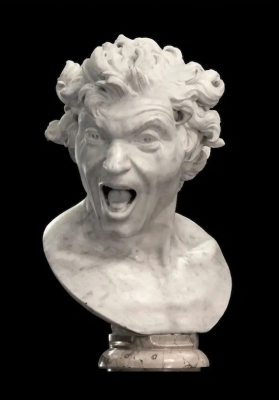Gospel in Art: Anyone who is angry with his brother will answer for it

Anima Dannata ('Damned Soul'), Bernini 1619 © Spanish Embassy to the Holy See, Rome
Source: Christian Art
Gospel of 12 February 2023
Matthew 5:20-22,27-28,33-34,37
Jesus said to his disciples: 'I tell you, if your virtue goes no deeper than that of the scribes and Pharisees, you will never get into the kingdom of heaven.
'You have learnt how it was said to our ancestors: You must not kill; and if anyone does kill he must answer for it before the court. But I say this to you: anyone who is angry with his brother will answer for it before the court.
'You have learnt how it was said: You must not commit adultery. But I say this to you: if a man looks at a woman lustfully, he has already committed adultery with her in his heart.
'Again, you have learnt how it was said to our ancestors: You must not break your oath, but must fulfil your oaths to the Lord. But I say this to you: do not swear at all. All you need say is "Yes" if you mean yes, "No" if you mean no; anything more than this comes from the evil one.'
Reflection on the Sculptural Bust
In today's Gospel reading we read that whoever kills will be liable to judgment. But Jesus dials it up a notch saying that anyone who is angry with his brother (or sister) will have to face justice too. I think that we can all agree that killing is very wrong, but getting angry with someone is a very different thing altogether? Why is Jesus so strong on this point of having to control our anger? He knows that letting anger live inside us is dangerous, as it can lead to resentment of the other, resentment of oneself and even of society. Living with anger makes one bitter and ultimately un-compassionate. Ultimately anger blocks love and therefore… blocks God out of our lives.
Our sculpture by Gian Lorenzo Bernini depicts an angry man shouting. Bernini made two similar busts in 1619, each reflecting states of the soul. As he put it: the Anima Beata ('Blessed Soul') contemplates the beauty and love of the soul destined for Heaven, while the Anima Damnata ('Damned Soul'), our sculpture of today, expresses all the terror of hell as a man consumed by anger. Some academics even think that our sculpture is a self portrait of the artist. The realism of the face is quite confrontational to someone standing in front of it. Bernini was only twenty when he carved this. Always pushing himself, he set himself the seemingly impossible challenge of carving the human soul in marble.
The surface of the sculpture is highly polished, which somehow magnifies the power of the anger... anger to the point of breaking out in sweat, and shining. Notice that the eyes are deeply hollowed out. The sculpture was standing in front of the fireplace in the Spanish Embassy in Rome, which commissioned the artwork. Bernini, to evoke the soul's internal anger and destination for Hell, deeply carved out the eye sockets and polished them intensely, so their shiny surface would capture and reflect the flames of the fire opposite the sculpture…
LINKS
Gospel in Art: https://christian.art/
Today's reflection: https://christian.art/daily-gospel-reading/matthew-5-20-22-27-28-33-34-37-2023/


















